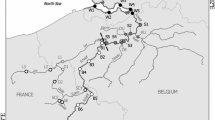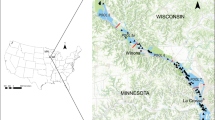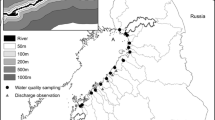Abstract
Aquatic ecosystems are subject to spatiotemporal variations that are important to quantify and understand for a proper assessment of their diversity and complexity. The objective of the present study was to develop a simple model that gives a numerical value to homogeneity and other spatiotemporal attributes for an easier analysis of aquatic ecosystem structure. The model allows for the comparison among different ecosystems, or different periods of time or zones of a given aquatic ecosystem. The model developed sets a numerical value to homogeneity, establishes the fraction of the ecosystem that contains a given percentage of the total amount of a compound, quantifies the fraction of the aquatic ecosystem in which no detectable levels of the measured compound are found, identifies the fraction of the ecosystem that represents an adequate habitat for a given process, and defines a simplified bidimensional vector of heterogeneity. This model is applicable to the two main maps used in the field of limnology: maps showing a particular parameter over two spatial dimensions, and maps showing a particular parameter over one spatial and one temporal dimension. The model was tested with different parameters obtained from three contrasting aquatic ecosystems, a highly polluted Mexican highland reservoir, a naturally acidic German bog lake, and a mesotrophic Patagonian lake.






Similar content being viewed by others
Abbreviations
- λ P :
-
Dead area/section of parameter P
- λ P, X :
-
Unidimensional (X) dead section of parameter P
- Ω P, X, Y :
-
Magnitude of the bidimensional (X, Y) vector of anisotropy for parameter P
- ω P, X, Y :
-
Direction of the bidimensional (X, Y) vector of anisotropy for parameter P
- A :
-
Grid cell area
- A′:
-
Cumulative normalized grid cell area
- \(A_{P}^{\% }\) :
-
Fraction of the map that contains a given percentage (superscript %) of parameter P
- \(A_{P,X}^{\% }\) :
-
Unidimensional (X) fraction of a profile, that contains a given percentage (superscript %) of parameter P
- C CH4 :
-
Concentration of disolved methane
- C DO :
-
Concentration of dissolved oxygen
- D :
-
Depth
- E h, P :
-
Relative absolute error of homogeneity factor for parameter P
- F P :
-
Flux of parameter P
- h P :
-
Homogeneity factor of parameter P
- h P, X :
-
Unidimensional (X) homogeneity factor of parameter P
- K S, CH4 :
-
Apparent affinity constant for methane
- K S, DO :
-
Apparent affinity constant for dissolved oxygen
- L :
-
Length
- L′:
-
Cumulative normalized length
- MP :
-
Methanotrophic potential
- M P :
-
Magnitude of parameter P present in grid cell area
- M′P :
-
Cumulative normalized magnitude of parameter P
- N P, X :
-
Unidimensional (X) magnitude of parameter P
- N′P,X :
-
Unidimensional (X) cumulative normalized magnitude of parameter P
- t :
-
Time
- CV:
-
Coefficient of variation
- DO:
-
Dissolved oxygen
- IC:
-
Inorganic carbon
- LF:
-
Lake Grosse Fuchskuhle
- LG:
-
Lake Guadalupe
- LG#:
-
Sampling sites in LG (1–8)
- LH:
-
Lake Hambre
- MAD:
-
Median absolute deviation
- NHM:
-
Numerical homogeneity model
- RWCS:
-
Relative water column stability
- TC:
-
Total carbon
- TN:
-
Total nitrogen
- TOC:
-
Total organic carbon
References
APHA (2012) Standard methods for the examination of water and wastewater, 22nd edn. American Public Health Association (APHA), American Water Works Association (AWWA), Water Environment Federation (WEF), Washington DC
Bagstad KJ, Semmens DJ, Ancona ZH, Sherrouse BC (2017) Evaluating alternative methods for biophysical and cultural ecosystem services hotspot mapping in natural resource planning. Landsc Ecol 32:77–97. https://doi.org/10.1007/s10980-016-0430-6
Bastviken D, Cole J, Pace M, Tranvik L (2004) Methane emissions from lakes: dependence of lake characteristics, two regional assessments, and a global estimate. Glob Biogeochem Cycl 18:GB4009. https://doi.org/10.1029/2004GB002238
Bellido JL, Tulonen T, Kankaala P, Ojala A (2013) Concentrations of CO2 and CH4 in water columns of two stratified boreal lakes during a year of atypical summer precipitation. Biogeochemistry 113:613–627. https://doi.org/10.1007/s10533-012-9792-2
Branco CWC, Kozlowsky-Suzuki B, Sousa-Filho IF, Guarino AWS, Rocha RJ (2009) Impact of climate on the vertical water column structure of Lajes Reservoir (Brazil): a tropical reservoir case. Lakes Reserv Res Manag 14:175–191. https://doi.org/10.1111/j.1440-1770.2009.00403.x
Delwiche KB, Hemond HF (2017) Methane bubble size distributions, flux, and dissolution in a freshwater lake. Environ Sci Technol 51:13733–13739. https://doi.org/10.1021/acs.est.7b04243
Descloux S, Chanudet V, Serca D, Guerin F (2017) Methane and nitrous oxide annual emissions from an old eutrophic temperate reservoir. Sci Total Environ 598:959–972. https://doi.org/10.1016/j.scitotenv.2017.04.066
Encinas Fernandez J, Peeters F, Hofmann H (2014) Importance of the autumn overturn and anoxic conditions in the hypolimnion for the annual methane emissions from a temperate lake. Environ Sci Technol 48:7297–7304. https://doi.org/10.1021/es4056164
Fraterrigo JM, Rusak JA (2008) Disturbance-driven changes in the variability of ecological patterns and processes. Ecol Lett 11:756–770. https://doi.org/10.1111/j.1461-0248.2008.01191.x
Geary RC (1954) The contiguity ratio and statistical mapping. Inc Stat 5(3):115–146. https://doi.org/10.2307/2986645
Gerardo-Nieto O, Astorga-Espana MS, Mansilla A, Thalasso F (2017) Initial report on methane and carbon dioxide emission dynamics from sub-Antarctic freshwater ecosystems: a seasonal study of a lake and a reservoir. Sci Total Environ 593–594:144–154. https://doi.org/10.1016/j.scitotenv.2017.02.144
Giling DP, Nejstgaard JC, Berger SA, Grossart HP, Kirillin G, Penske A, Lentz M, Casper P, Sareyka J, Gessner MO (2017) Thermocline deepening boosts ecosystem metabolism: evidence from a large-scale lake enclosure experiment simulating a summer storm. Glob Change Biol 23:1448–1462. https://doi.org/10.1111/gcb.13512
Gonzalez-Valencia R, Sepulveda-Jauregui A, Martinez-Cruz K, Hoyos-Santillan J, Dendooven L, Thalasso F (2014) Methane emissions from Mexican freshwater bodies: correlations with water pollution. Hydrobiologia 721:9–22. https://doi.org/10.1007/s10750-013-1632-4
Gonzalez-Valencia R, Magana-Rodriguez F, Cristobal J, Thalasso F (2016) Hotspot detection and spatial distribution of methane emissions from landfills by a surface probe method. Waste Manag 55:299–305. https://doi.org/10.1016/j.wasman.2016.03.004
Gustafson EJ (1998) Quantifying landscape spatial pattern: what is the state of the art? Ecosystems 1:143–156. https://doi.org/10.1007/s100219900011
He FL, LaFrankie JV, Song B (2002) Scale dependence of tree abundance and richness in a tropical rain forest, Malaysia. Landsc Ecol 17:559–568. https://doi.org/10.1023/A:1021514104193
Hofmann H (2013) Spatiotemporal distribution patterns of dissolved methane in lakes: how accurate are the current estimations of the diffusive flux path? Geophys Res Lett 40:2779–2784. https://doi.org/10.1002/grl.50453
Hofmann H, Federwisch L, Peeters F (2010) Wave-induced release of methane: littoral zones as a source of methane in lakes. Limnol Oceanogr 55:1990–2000. https://doi.org/10.4319/lo.2010.55.5.1990
Hutchinson GE, Löffler H (1956) The thermal classification of lakes. Proc Natl Acad Sci USA 42:84–86. https://doi.org/10.1073/pnas.42.2.84
Imboden DM, Wüest A (1995) Mixing mechanisms in lakes. In: Lerman A, Imboden DM, Gat JR (eds) Physics and chemistry of lakes. Springer, Berlin, pp 83–138
Jane SF, Rose KC (2018) Carbon quality regulates the temperature dependence of aquatic ecosystem respiration. Freshw Biol 63:1407–1419. https://doi.org/10.1111/fwb.13168
Kaizu Y, Iio M, Yamada H, Noguchi N (2011) Development of unmanned airboat for water-quality mapping. Biosyst Eng 109:338–347. https://doi.org/10.1016/j.biosystemseng.2011.04.013
Legendre P, Fortin MJ (1989) Spatial pattern and ecological analysis. Vegetatio 80:107–138. https://doi.org/10.1007/BF00048036
Li BL (1995) Wavelet analysis for characterizing spatial heterogeneity in the subsurface. In: Laine AF, Unser MA (eds) Proceedings of the society of photo-optical instrumentation engineers (SPIE). SPIE, Washington, pp 736–746
Martinez-Cruz K, Sepulveda-Jauregui A, Anthony KW, Thalasso F (2015) Geographic and seasonal variation of dissolved methane and aerobic methane oxidation in Alaskan lakes. Biogeosciences 12:4595–4606. https://doi.org/10.5194/bg-12-4595-2015
Matheron G (1963) Principles of geostatistics. Econ Geol 58(8):1246–1266. https://doi.org/10.2113/gsecongeo.58.8.1246
Meteored (2016) Histórico del Clima en Cuautitlán Izcalli. https://www.meteored.mx/cuautitlan-izcalli/historico. Accessed 24 May 2016
Moran PAP (1950) Notes on continuous stochastic phenomena. Biometrika 37:17–23
Murase J, Sakai Y, Kametani A, Sugimoto A (2005) Dynamics of methane in mesotrophic Lake Biwa, Japan. Ecol Res 20:377–385. https://doi.org/10.1007/s11284-005-0053-x
Padisák J, Barbosa F, Koschel R, Krienitz L (2003) Deep layer cyanoprokaryota maxima in temperate and tropical lakes. Adv Limnol 58:175–199
Pannard A, Bormans M, Lagadeuc Y (2008) Phytoplankton species turnover controlled by physical forcing at different time scales. Can J Fish Aquat Sci 65:47–60. https://doi.org/10.1139/F07-149
Rajala T, Redenbach C, Särkka A, Sormani M (2018) A review on anisotropy analysis of spatial point patterns. Spat Stat 28:141–168. https://doi.org/10.1016/j.spasta.2018.04.005
Rosenberg MS (2000) The bearing correlogram: a new method of analyzing directional spatial autocorrelation. Geogr Anal 32:267–278
Segers R (1998) Methane production and methane consumption: a review of processes underlying wetland methane fluxes. Biogeochemistry 41:23–51. https://doi.org/10.1023/A:1005929032764
Sepulveda-Jauregui A, Martinez-Cruz K, Strohm A, Anthony KMW, Thalasso F (2012) A new method for field measurement of dissolved methane in water using infrared tunable diode laser absorption spectroscopy. Limnol Oceanogr Methods 10:560–567. https://doi.org/10.4319/lom.2012.10.560
Sepulveda-Jauregui A, Hoyos-Santillan J, Gutierrez-Mendieta FJ, Torres-Alvarado R, Dendooven L, Thalasso F (2013) The impact of anthropogenic pollution on limnological characteristics of a subtropical highland reservoir “Lago de Guadalupe”. Mexico. Knowl Manag Aquat Ecosyst. https://doi.org/10.1051/kmae/2013059
Sepulveda-Jauregui A, Hoyos-Santillan J, Martinez-Cruz K, Anthony KMW, Casper P, Belmonte-Izquierdo Y, Thalasso F (2018a) Eutrophication exacerbates the impact of climate warming on lake methane emission. Sci Total Environ 636:411–419. https://doi.org/10.1016/j.scitotenv.2018.04.283
Sepulveda-Jauregui A, Martinez-Cruz K, Lau M, Casper P (2018b) Assessment of methane and carbon dioxide emissions in two sub-basins of a small acidic bog lake artificially divided 30 years ago. Freshw Biol 63:1534–1549. https://doi.org/10.1111/fwb.13182
Steinle L, Graves CA, Treude T, Ferre B, Biastoch A, Bussmann I, Berndt C, Krastel S, James RH, Behrens E, Boning CW, Greinert J, Sapart CJ, Scheinert M, Sommer S, Lehmann MF, Niemann H (2015) Water column methanotrophy controlled by a rapid oceanographic switch. Nat Geosci 8:378–382. https://doi.org/10.1038/Ngeo2420
Striegl RG, Michmerhuizen CM (1998) Hydrologic influence on methane and carbon dioxide dynamics at two north-central Minnesota lakes. Limnol Oceanogr 43:1519–1529. https://doi.org/10.4319/lo.1998.43.7.1519
Thah PH, Sitanggang IS (2016) Contextual outlier detection on hotspot data in Riau Province using k-means algorithm. In: 2nd international symposium on Lapan-Ipb Satellite (Lisat) for food security and environmental monitoring, vol 33, pp 258–268
Veldtman R (2005) The ecology of southern African wild silk moths (Gonometa Species, Lepidoptera: Lasiocampidae): consequences for their sustainable use. Dissertation, University of Pretoria
Wang JF, Zhang TL, Fu BJ (2016) A measure of spatial stratified heterogeneity. Ecol Indic 67:250–256. https://doi.org/10.1016/j.ecolind.2016.02.052
Watkins JM, Weidel BC, Rudstam LG, Holeckl KT (2015) Spatial extent and dissipation of the deep chlorophyll layer in Lake Ontario during the Lake Ontario lower foodweb assessment, 2003 and 2008. Aquat Ecosyst Health Manag 18:18–27. https://doi.org/10.1080/14634988.2014.937316
Weber UW, Cook PG, Brennwald MS, Kipfer R, Stieglitz TC (2019) A novel approach to quantify air–water gas exchange in shallow surface waters using high-resolution time series of dissolved atmospheric gases. Environ Sci Technol 53:1463–1470. https://doi.org/10.1021/acs.est.8b05318
Wik M, Crill PM, Varner RK, Bastviken D (2013) Multiyear measurements of ebullitive methane flux from three subarctic lakes. J Geophys Res Biogeosci 118:1307–1321. https://doi.org/10.1002/jgrg.20103
Willmott CJ, Matsuura K (2006) On the use of dimensioned measures of error to evaluate the performance of spatial interpolators. Int J Geogr Inf Sci 20:89–102. https://doi.org/10.1080/13658810500286976
Winder M, Hunter DA (2008) Temporal organization of phytoplankton communities linked to physical forcing. Oecologia 156:179–192. https://doi.org/10.1007/s00442-008-0964-7
Acknowledgements
We gratefully acknowledge Consejo Nacional de Ciencia y Tecnología (Conacyt), Mexico for financial support to Rodrigo Gonzalez-Valencia, Felipe Magana-Rodriguez, and Teresa Aguirrezabala-Campano (Grant nos. 266244, 419562, and 531383, respectively). We also thank Secretaría del Medio Ambiente y Recursos Naturales (Semarnat) for financial support received through project 23661, and Victoria T. Velázquez-Martínez, Juan Corona-Hernández, Francisco Silva-Olmedo, and David Flores-Rojas for technical assistance.
Author information
Authors and Affiliations
Corresponding author
Ethics declarations
Conflict of interest
The authors declare that they have no conflicts of interest.
Additional information
Publisher's Note
Springer Nature remains neutral with regard to jurisdictional claims in published maps and institutional affiliations.
Electronic supplementary material
Below is the link to the electronic supplementary material.
Rights and permissions
About this article
Cite this article
Gonzalez-Valencia, R., Magaña-Rodriguez, F., Sepulveda-Jauregui, A. et al. A simple model for the numerical characterization of spatiotemporal variability in aquatic ecosystems. Aquat Sci 81, 58 (2019). https://doi.org/10.1007/s00027-019-0652-1
Received:
Accepted:
Published:
DOI: https://doi.org/10.1007/s00027-019-0652-1




